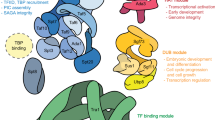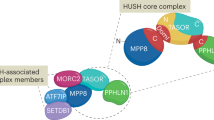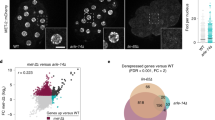Abstract
Silencing is an epigenetic form of transcriptional regulation whereby genes are heritably, but not necessarily permanently, inactivated. We have identified the Saccharomyces cerevisiae genes SAS2 and SAS3 through a screen for enhancers of sir1 epigenetic silencing defects. SAS2, SAS3 and a Schizosaccharomyces pombe homologue are closely related to several human genes, including one associated with acute myeloid leukaemia arising from the recurrent translocation t(8;16)(p11;p13) and one implicated in HIV–1 Tat interactions. All of these genes encode proteins with an atypical zinc finger and well–conserved similarities to acetyltransferases. Sequence similarities and yeast mutant phenotypes suggest that SAS–like genes function in transcriptional regulation and cell–cycle exit and reveal novel connections between transcriptional silencing and human disease.
This is a preview of subscription content, access via your institution
Access options
Subscribe to this journal
Receive 12 print issues and online access
$209.00 per year
only $17.42 per issue
Buy this article
- Purchase on Springer Link
- Instant access to full article PDF
Prices may be subject to local taxes which are calculated during checkout
Similar content being viewed by others
References
Bird, A.P. Gene number, noise reduction and biological complexity. Trends. Genet. 11, 94–100 (1995).
Loo, S. & Rine, J. Silencing and heritable domains of gene expression. Annu. Rev. Cell. Biol. Dev 11, 519–548 (1995).
Hebbes, T.R., Thome, A.W. & Crane-Robinson, C. A direct link between core histone acetylation and transcriptionally active chromatin. EMBO. J. 7, 1395–1402 (1988).
Lee, D., Hayes, J., Pruss, D. & Wolffe, A. A positive role for histone acetylation in transcription factor access to nucleosomal DNA. Cell 72, 73–84 (1993).
Pillus, L. & Grunstein, M., Structure and Epigenetic Regulation in Yeast. in Chromatin Structure and Gene Expression (ed. Elgin, S.C.R.) (IRL Press, Oxford University Press, 1995).
Braunstein, M., Rose, A.B., Holmes, S.G., Allis, C.D. & Broach, J.R. Transcriptional silencing in yeast is associated with reduced nucleosome acetylation. Genes. Dev. 7, 592–604 (1993).
Whiteway, M., Freedman, R., Arsdell, S.V., Szostak, J.W. & Thomer, J. The yeast ARD1 gene product is required for repression of cryptic mating-type information at the HML locus. Mol. Cell. Biol. 7, 3713–22 (1987).
Mullen, J.R. et al. Identification and characterization of genes and mutants for an N-terminal acetyltransferase from yeast. EMBO. J. 8, 2067–2075 (1989).
Lee, F.-J.S., Lin, L.-W. & Smith, J.A. Nα-acetylation is required for normal growth and mating of Saccharomyces cerevisiae . J. Bacteriol. 171, 5795–5802 (1989).
Aparicio, O.M., Billington, B.L. & Gottschling, D.E. Modifiers of position effect are shared between telomeric and silent mating-type loci in S. cerevisiae . Cell 66, 1279–1287 (1991).
Pillus, L. & Rine, J. Epigenetic inheritance of transcriptional states in S. cerevisiae. Cell 59, 637–647 (1989).
Rivier, D. & Rine, J. Silencing: the establishment and inheritance of stable, repressed transcription states. Curr. Opin. Genet. Dev. 2, 286–292 (1992).
Miller, A.M. & Nasmyth, K.A. Role of DNA replication in the repression of silent mating type loci in yeast. Nature 312, 247–251 (1984).
Rine, J. & Herskowitz, I. Four genes responsible for a position effect on expression from HML and HMR in Saccharomyces cerevisiae . Genetics 116, 9–22 (1987).
Renauld, H., Aparicio, O.M., Zierath, P.D., Billington, B.L., Chhablani, S.K. & Gottschling, D.E. Silent domains are assembled continuously from the telomere and are defined by promoter distance and strength, and by SIR3 dosage. Genes. Dev. 7, 1133–1145 (1993).
Chien, C.-T., Buck, S., Sternglanz, R. & Shore, D. Targeting of SIR1 protein establishes transcriptional silencing at HM loci and telomeres in yeast. Cell 75, 531–541 (1993).
Gottschling, D.E., Aparicio, O.M., Billington, B.L. & Zakian, V.A. Position effect at S. cerevisiae telomeres: Reversible repression of Pol II transcription. Cell 63, 751–762 (1990).
Mahoney, D., Marquardt, R., Shei, G., Rose, A. & Broach, J. Mutations in the HML E silencer of Saccharomyces cerevisiae yield metastable inheritance of trancriptional repression. Genes. Dev. 5, 605–615 (1991).
Sussel, L., Vannier, D. & Shore, D., Epigenetic switching of transcriptional states: cis-and trans-acting factors affecting establishment of silencing at the HMR locus in Saccharomyces cerevisiae . Mol. Cell. Biol. 13, 3919–3928 (1993).
Karpen, G.H. Position-effect variegation and the new biology of heterochromatin. Curr. Opin. Genet. Dev. 4, 281–291 (1994).
Lyon, M.F. Controlling the Xchromosome. Curr. Biol. 3, 242–244 (1993).
Kamine, J., Elangovan, B., Subramanian, T., Coleman, D. & Chinnadurai, G. Identification of a cellular protein that specifically interacts with the essential cysteine region of the HIV-1 Tat transactivator. virology 216, 357–366 (1996).
Borrow, J. et al. The translocation t(8;16)(p11;p13) of acute myeloid leukaemia fuses a putative acetyltransferase to the CREB-binding protein. Nature. Genet. 14, 33–41 (1996).
Spencer, F., Gerring, S.L., Connelly, C. & Hieter, P. Mitotic chromosome transmission fidelity mutants in Saccharomyces cerevisiae . Genetics 124, 237–249 (1990).
Olson, M.V. et al. Random-clone strategy for genomic restriction mapping in yeast. Proc. Natl. Acad. Sci. USA 83, 7826–7830 (1986).
Link, A.J. & Olson, M.V. Physical map of the Saccharomyces cerevisiae genome at 110-kb resolution. Genetics 127, 681–698 (1991).
Riles, L. et al. Physical maps of the six smallest chromosomes of Saccharomyces cerevisiae at a resolution of 2.6 kilobase pairs. Genetics 134, 81–150 (1993).
Altschul, S.F., Gish, W., Miller, W., Myers, E.W. & Lipman, D.J. Basic local alignment search tool. J. Mol. Biol. 215, 403–410 (1990).
Boguski, M.S., Lowe, T.M.J. & Tolstoshev, C.M. dbEST-database for “expressed sequence tags.” Nature Genet. 4, 332–333 (1993).
Bassett, D.E., Boguski, M.S., Spencer, F., Reeves, R., Goebl, M. & Hieter, P. Comparative genomics, genome cross-referencing and XREFdb. Trends Genet. 11, 372–373 (1995).
Scherens, B., El Bakkoury, M., Vierendeels, F., Dubois, E. & Messenguy, F. Sequencing and functional analysis of a 32,650 bp segment on the left arm of yeast chromosome II. Identification of 26 open reading frames, including the KIP1 and SEC17 genes. Yeast 9, 1355–1371 (1993).
Hanslip, J.I., Swansbury, G.J., Pinkerton, R. & Catovsky, D. The translocation t(8;16)(p11;p13) defines an AML subtype with distinct cytology and clinical features. Leuk. Lymph. 6, 479–486 (1992).
Tercero, J.C., Riles, L.B. & Wickner, R.B. Localized mutagenesis and evidence for post-transcriptional regulation of MAK3 . J. Biol. Chem. 267, 20270–20276 (1992).
Kleff, S., Andrulis, E.D., Anderson, C.W. & Sternglanz, R. Identification of a gene encoding a yeast histone H4 acetyltransferase. J. Biol. Chem. 270, 24674–25677 (1995).
Brownell, J.E. et al. Tetrahymena histone acetyltransferase A: a transcriptional co-activator linking gene expression to histone acetylation. Cell 84, 843–851 (1996).
Rothstein, R. Targeting, disruption, replacement, and allele rescue: integrative DNA transformation in yeast. Meth. Enzym. 194, 281–301 (1991).
Boeke, J.D., Trueheart, J., Natsoulis, G. & Fink, G.R. 5-Fluoroorotic acid as a selective agent in yeast molecular genetics. Meth. Enzym. 154, 164–175 (1987).
Dillin, A. & Rine, J. On the origin of a silencer. Trends. Biochem. Sci. 20, 231–235 (1995).
Brand, A.H., Micklem, G. & Nasmyth, K. A yeast silencer contains sequences that can promote autonomous plasmid replication and transcriptional activation. Cell 51, 709–19 (1987).
Kimmerly, W., Buchman, A., Kornberg, R. & Rine, J. Roles of two DNA-binding factors in replication, segregation and transcriptional repression mediated by a yeast silencer. EMBO. J. 7, 2241–2253 (1988).
Axelrod, A. & Rine, J. A role for CDC7 in repression of transcription at the silent mating-type locus HMR in Saccharomyces cerevisiae . Mol. Cell. Biol. 11, 1080–1091 (1991).
Shore, D. RAP1: a protean regulator in yeast. Trends. Genet. 10, 408–412 (1994).
Kennedy, B.K., Austriaco, N.R., Zhang, J. & Guarente, L. Mutation in the silencing gene SIR4 can delay aging in S. cerevisiae . Cell 80, 485–496 (1995).
Sherman, F., Moerschell, R.P., Tsunasawa, S., Sternglanz, R. & Dumont, M.E., Co-and post-translational processes and mitochondrial import of yeast cytochrome c. Translational. Regulation. of. Gene. Expression Vol. II (ed. llan, J.) (Plenum Press, 1993).
Brownell, J.E. & Allis, C.D., HATs for special occasions: linking histone acetylation to chromatin assembly and gene activation. Curr. Opin. Genet. Dev. 6, 176–184 (1996).
Taunton, J., Hassig, C.A. & Schreiber, S.L. A mammalian histone deacetylase related to the yeast transcriptional regulator Rpd3. Science 272, 408–411 (1996).
Berg, J.M. & Shi, Y. The galvanization of biology: a growing appreciation for the roles of zinc. Science 271, 1081–1085 (1996).
Baldarelli, R. et al. Transcripts of the Drosophila blastoderm-specific locus, terminus, are concentrated posteriorly and encode a potential DNA-binding finger. Dev. Biol. 125, 85–95 (1988).
Ruiz-i-Abata, A., Perry-O'Keefe, H. & Melton, D. Xfin: an embryonic gene encoding a mutifingered protein in Xenopus . EMBO. J. 6, 3065–3070 (1987).
Morishita, K., Parker, D., Mucenski, M., Jenkins, N., Copeland, N. & Ihle, J. Retroviral activation of a novel gene encoding a zinc finger protein in IL-3-dependent myeloid leukemia lines. Cell 54, 831–840 (1988).
Tercero, J.C. & Wickner, R.B. MAK3 encodes an N-acetyltransferase whose modification of the L-A gag NH2 terminus is necessary for virus particle assembly. J. Biol. Chem. 267, 20277–20281 (1992).
Shaw, W.V. & Leslie, A.G.W. Chloramphenical acetyltransferase. Annu. Rev. Biophys. Chem. 20, 363–386 (1991).
Candau, R. et al. Identification of human proteins functionally conserved with the yeast putative adaptors ADA2 and GCN5. Mol. Cell. Biol. 16, 593–602 (1996).
Georgakopoulos, T. & Thieros, G. Two distinct yeast transcriptional activators require the function of the GCN5 protein to promote normal levels of transcription. EMBO. J. 11, 4145–4152 (1992).
Marcus, G., Silverman, N., Berger, S., Horiuchi, J. & Guarente, L. Functional similarity and physical association between GCN5 and ADA2: putative transcriptional adaptors. EMBO. J. 13, 4807–4815 (1994).
Chrivia, J.C., Kwok, R.P.S., Lamb, N., Hagiwara, M., Montminy, M.R. & Goodman, R.H. Phosphorylated CREB binds specifically to the nuclear protein CBP. Nature 365, 855–859 (1993).
Brownell, J.E. & Allis, C.D. An activity gel assay detects a single, catalytically active histone acetyltransferase subunit in Tetrahymena macronuclei. Proc. Natl. Acad. Sci. USA 92, 6364–6368 (1995).
Brachmann, C.B., Sherman, J.M., Devine, S.E., Cameron, E.E., Pillus, L. & Boeke, J.D. SIR2 gene family, conserved from bacteria to humans, functions in silencing, cell cycle progression and chromosome stability. Genes. Dev. 9, 2888–2902 (1995).
Savitsky, K. et al. A single ataxia telangiectasia gene with a product similar to PI-3 kinase. Science 268, 1749–1753 (1995).
Greenwell, P.W., Kronmal, S., Porter, S.E., Gasenhuber, J., Obermaier, B. & Petes, T.D. TEL1, a gene involved in controlling telomere length in S. cerevisiae, is homologous to the human Ataxia telangiectasia gene. Cell 82, 823–829 (1995).
Morrow, D.W., Tagle, D.A., Shiloh, Y., Collins, F.S. & Hieter, P. TEL1, an S. cerevisiae homolog of the human gene mutated in Ataxia telaniectasia, is functionally related to the yeast checkpoint gene MEC1. Cell 82, 831–840 (1995).
Bassett, D.E., Boguski, M.S. & Hieter, P. Yeast genes and human disease. Nature 379, 589–590 (1996).
Rose, M.D., Meluh, P.B. & Hieter, P. Methods. in. Yeast. Genetics. (Cold Spring Harbor Laboratory Press, Cold Spring Harbor, New York, 1990).
Sprague, G.F. Assay of yeast mating reaction. Meth. Enzym. 194, 77–93 (1991).
Lawrence, C.W. Classical mutagenesis techniques. Meth. Enzym. 194, 273–281 (1991).
Orr, W.T., Nicolas, A. & Szostak, J.W. Gene conversion adjacent to regions of double-strand break repair. Mol. Cell. Biol. 8, 5292–5298 (1988).
Kulkami, M.S. & Sherman, F. NAT2, an essential gene encoding methionine Nα-acetyltransferase in the yeast Saccharomyces. cerevisiae . J. Biol. Chem. 269, 13141–13147 (1994).
Author information
Authors and Affiliations
Rights and permissions
About this article
Cite this article
Reifsnyder, C., Lowell, J., Clarke, A. et al. Yeast SAS silencing genes and human genes associated with AML and HIV–1 Tat interactions are homologous with acetyltransferases. Nat Genet 14, 42–49 (1996). https://doi.org/10.1038/ng0996-42
Received:
Accepted:
Issue Date:
DOI: https://doi.org/10.1038/ng0996-42
This article is cited by
-
KAT6A mutations in Arboleda-Tham syndrome drive epigenetic regulation of posterior HOXC cluster
Human Genetics (2023)
-
A MYST Histone Acetyltransferase Modulates Conidia Development and Secondary Metabolism in Pestalotiopsis microspora, a Taxol Producer
Scientific Reports (2018)
-
Decreased MORF leads to prolonged endoplasmic reticulum stress in periodontitis-associated chronic inflammation
Cell Death & Differentiation (2016)
-
50 years of protein acetylation: from gene regulation to epigenetics, metabolism and beyond
Nature Reviews Molecular Cell Biology (2015)
-
A dual role of H4K16 acetylation in the establishment of yeast silent chromatin
The EMBO Journal (2011)



